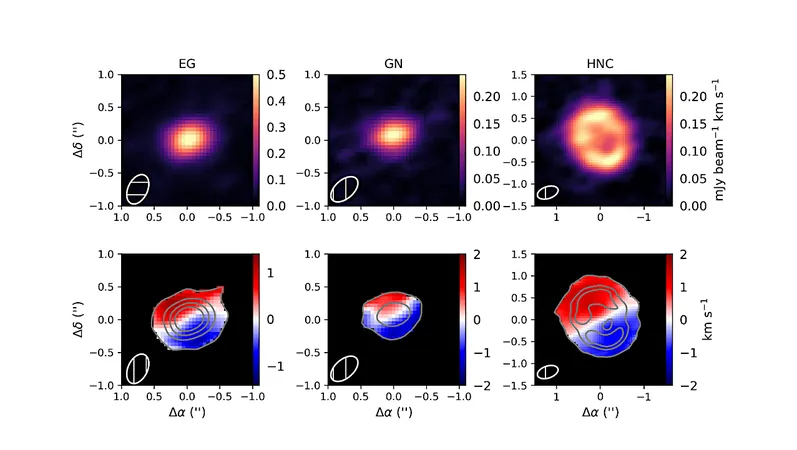
Unveiling the Cosmic Building Blocks: Ethylene Glycol and Glycolonitrile Detected in V883 Ori Protoplanetary Disk!
2025-09-11
Author: Sarah
A Breakthrough in Astrobiology
Astrobiologists are buzzing with excitement following a groundbreaking discovery in the cosmos. Recent observations have identified ethylene glycol (EG) and glycolonitrile (GN) within the protoplanetary disk around the dynamic protostar V883 Ori. These molecules are not just random cosmic dust; they are considered vital precursors to the very building blocks of life, including nucleic acids.
What Are These Molecules?
Ethylene glycol, a type of sugar alcohol, exists as the reduced version of glycolaldehyde—a compound that plays a significant role in biological processes. Glycolonitrile, on the other hand, is a key player in the formation of adenine, a fundamental nucleotide, and potentially contributes to the creation of glycine, an essential amino acid. The presence of such prebiotic compounds in space is becoming increasingly common, sparking intrigue about how these molecules could support life.
Exploring V883 Ori: The Habitat of Life's Ingredients
Using the powerful Atacama Large Millimeter/sub-millimeter Array (ALMA), researchers observed these intriguing emissions from V883 Ori’s disk. The findings indicate that EG was detected with a column density of approximately 3.63 x 10^16 cm^-2 at a scorching temperature of 300 K. Similarly, GN's emissions suggest comparable density and a temperature hovering around 88 K. This suggests a complex chemical environment supportive of life-forming processes.
Where Do V883 Ori’s Molecules Stand? An Astrophysical Perspective
In comparison to other celestial bodies, V883 Ori strikes a balance between 'hot cores'—regions rich in complex molecules—and comets, hinting at an ongoing evolution of prebiotic chemistry even as planets begin to take shape. This suggests that as planets form, they may absorb key components crucial for developing life, potentially increasing their habitability.
Future Investigations Ahead!
To deepen our understanding of these findings, additional high-resolution observations of the protoplanetary disk are imperative. Confirming these initial detections could pave the way for uncovering how molecular complexity is achieved in space and ultimately, how life on Earth—and beyond—might have originated.
Stay Tuned for More Cosmic Discoveries!
With the mysteries of our universe still unfolding, the detection of EG and GN is just the tip of the iceberg. As we push the boundaries of astrobiology and astrochemistry, who knows what astonishing revelations await?


 Brasil (PT)
Brasil (PT)
 Canada (EN)
Canada (EN)
 Chile (ES)
Chile (ES)
 Česko (CS)
Česko (CS)
 대한민국 (KO)
대한민국 (KO)
 España (ES)
España (ES)
 France (FR)
France (FR)
 Hong Kong (EN)
Hong Kong (EN)
 Italia (IT)
Italia (IT)
 日本 (JA)
日本 (JA)
 Magyarország (HU)
Magyarország (HU)
 Norge (NO)
Norge (NO)
 Polska (PL)
Polska (PL)
 Schweiz (DE)
Schweiz (DE)
 Singapore (EN)
Singapore (EN)
 Sverige (SV)
Sverige (SV)
 Suomi (FI)
Suomi (FI)
 Türkiye (TR)
Türkiye (TR)
 الإمارات العربية المتحدة (AR)
الإمارات العربية المتحدة (AR)